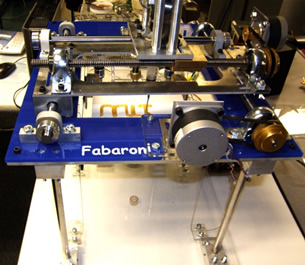How to Make Anything ... Almost
MIT's Fab Lab seeks to bridge the technology divide by offering self-sustaining fabrication to under-served communities worldwide.
September 11, 2008
By Susan Smith
 In March, Fab Labs around the world participated in an Easter Egg contest. Thomas Renouvin’s egg (inset) and Lass’s Vegas egg are among the esteemed entries. |
A partial answer to the world’s need for consumer items could be Massachusetts Institute of Technology’s (MIT) Center for Bits and Atoms’ (CBA) Fab Lab, a rapid prototyping platform that is essentially a collection of “off-the-shelf, industrial-grade fabrication and electronics tools that is wrapped in open source software and programs written by researchers at the Center for Bits and Atoms,” according to CBA.
In 2004, the NSF initially funded MIT’s Center for Bits and Atoms, self described as “an ambitious interdisciplinary initiative that is looking beyond the end of the Digital Revolution to ask how a functional description of a system can be embodied in, and abstracted from, a physical form.”
Fab Lab, which stands for “Fabrication Laboratory,” is the education outreach arm of CBA, a package of tools that can bridge the divide between instrumentation and fabrication and make product development accessible to a wide range of people in under-served communities, those who otherwise would not be able to access or deploy technology.
Currently Fab Lab is home to the following tools: a laser cutter that makes 2D and 3D structures, a sign cutter that plots in copper to make antennas and flex circuits, a high-resolution milling machine that makes circuit boards and precision parts, and a suite of electronic components and programming tools for low-cost, high-speed microcontrollers. MIT researchers have written a CAM program that can read numerous ways that people describe things digitally and turn them into tool paths for the numerous ways they can make things. They have also written a teaching program for Fab Labs.
This program helps users share their files and experiences as they work, allowing them to learn from each other as their experiences evolve, rather than working with a fixed curriculum.
Users learn computing, electronics, programming and CAD/CAM fabrication techniques using Fab Lab. The Fab Lab community is international and attracts trained engineers who can work on real life design problems and bring technology to communities that otherwise would not be able to create consumer items.
MIT’s Fab Lab includes a 3D printer from ZCorp, a Stratasys FDM printer, a Minolta 3D scanner, plus information on how to make your own 3D printer and scanner. An example given is the Fabaroni, a 3D printing machine that constructs 3D models with pasta dough, created in physicist and MIT professor Neil Gershenfeld’s “How to Make (Almost) Anything” course offered at MIT. Other tools include a Zeiss confocal microscope, molding and casting technologies, circuits and microcontrollers, 3D modeling and graphics design tools.
 The Fabaroni is a 3D printing machine that constructs 3D models with pasta dough. Fabaroni’s gantry has a moving Z-stage and a head with pasta-extruder moving in the X-Y directions. Fabaroni takes STL files as input, processes them using Python, and prints to the machine via six printed circuit boards. |
Fab Lab is suited for do-it-yourselfers who can take their own ideas to the prototyping stage quickly and develop products, or businesses. To put together a full Fab Lab costs approximately $25,000-$50,000 in equipment and materials, without the help of MIT, so it is an affordable solution that could result in a “Star-Trek-style replicator” in the next 20 years, to coin Gershenfeld’s words, that could produce almost anything you need.
Gershenfeld, the 49-year-old inventor of the Fab Lab, wants to bring a version of that replicator to communities in countries around the world. Since 2002, Gershenfeld has shipped 26 Fab Labs around the world.
Today, Fab Lab is responsible for radio frequency (RFID) ID tags created by Norwegian shepherds who use them to track their sheep. A Fab Lab was shipped to Afghanistan this year for the purpose of creating prosthetic limbs. Fab Lab users in Pabal, India are building replacement gears for legacy copying machines, analysis tools to test milk content and running diagnostics on human blood. The Takoradi Technical Institute in Ghana has a Fab Lab used by students working on mobile refrigeration and TV antenna designs. Sun Microsystems and Cisco are working with the South African government to build simple Internet-connected computers that can hook up to televisions using Fab Lab components — with the ultimate cost of $10 apiece.
Future plans include — what else? A Fab Lab that can replicate itself. In addition, Gershenfeld is seeking ways to make the Fab Lab network self-sustaining, as it seeks to make its users self-sustaining. So far the project has been funded by the National Science Foundation (NSF) and contributions from local governments and nonprofits.
To address this financial need, his brother, Alan and fellow venture capitalist Michael Angst, have spawned the Fab Fund, a for-profit project that would invest in for-profit businesses that manufacture their products using Fab Labs, what they call “micro-venture capitalism.” In true community spirit, each Fab Lab will have the opportunity to spend a portion of its time building another user’s Fab-Fund-sponsored product, in exchange for some sponsorship, in addition to building whatever the owner wants.
The intent of the Fab Fund is two-pronged: the Fab Labs will broaden their outreach and become more accessible and affordable to a greater number and variety of users.
Gershenfeld’s vision is broad: if ordinary people in all parts of the world can create their own tools and technology, or anything else they need, a paradigm shift in the way we do business on the planet will result.
Fab Lab
Massachusetts Institute of Technology (MIT)
Boston, MA
MITCenter for Bits and Atoms
Massachusetts Institute of Technology (MIT)
Boston, MA
Susan Smith is a contributing editor for Desktop Engineering Magazine. She has been an editor and writer for the technology industry for more than 15 years and resides in Santa Fe, NM. Send e-mail about this article to [email protected].
Subscribe to our FREE magazine, FREE email newsletters or both!
About the Author
DE’s editors contribute news and new product announcements to Digital Engineering.
Press releases may be sent to them via [email protected].






